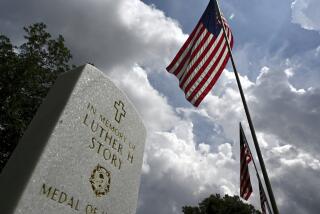Einar H. Ingman Jr. dies at 85; soldier received Medal of Honor for valor in Korean War
Einar H. Ingman Jr., a Wisconsin farmer’s son whose unflinching assault on two machine gun nests during the Korean War repelled more than 100 enemy troops and brought him the Medal of Honor, has died. He was 85.
His death Sept. 9 in Tomahawk, Wis., was announced by the Congressional Medal of Honor Society. The cause of death was not given.
Born in Milwaukee on Oct. 6, 1929, Ingman joined the Army at 19, hoping for the opportunity to operate heavy equipment. Instead, he became a rifleman with the Seventh Infantry Division.
On Feb. 26, 1951, the 21-year-old corporal found his platoon pinned down by enemy fire while attacking a strongly fortified ridge held by the enemy near Maltari, Korea.
When several men were injured — including the leaders of the two squads heading the assault — Ingman took over.
What followed was “conspicuous gallantry and intrepidity above and beyond the call of duty,” according to his citation for the Medal of Honor, the nation’s highest award for valor in combat.
During a fusillade of machine gun fire, Ingman charged one of the enemy positions alone. He threw a grenade into the nest, then with his rifle killed the rest of the crew.
About 15 yards away, the gunners in a second emplacement began raking Ingman and his men, inflicting more casualties. Ingman charged again. This time he was hit by grenade shrapnel that severed his left ear and knocked him to the ground.
While struggling to his feet he was shot in the face. The bullet tore through his mouth and came out behind his injured ear.
Ingman somehow pressed on.
“With incredible courage and stamina, he arose instantly and, using only his rifle, killed the entire gun crew before falling unconscious from his wounds,” the medal citation said.
The remaining enemy troops threw down their weapons and retreated.
A week later, Ingman woke up in a Tokyo hospital. He was blind in his left eye, had lost the hearing in his left ear, and could not remember the attack or even his name.
Back in the United States, he underwent 23 surgeries over two years. “Although he recovered physically, his memory would come and go,” Peter Collier wrote in “Medal of Honor,” a 2011 book profiling 144 Medal of Honor recipients.
Ingman was flown from the hospital to Washington, D.C., where he received the medal from President Truman on July 5, 1951.
He returned home to the small northern Wisconsin town of Tomahawk, where he worked for three decades as a security guard and later as a mail clerk.
Mardelle Ingman, his wife of nearly 60 years, died in 2011. He is survived by seven children, a sister, two brothers, eight grandchildren and six great-grandchildren.
Several years ago, his wife recalled in the Milwaukee Journal Sentinel what Ingman often said about the medal.
“I don’t wear it for myself,” he said. “I wear it for all the men that didn’t come back.”
Twitter: @ewooLATimes
MORE OBITUARIES:
Eric Harris Davidson dies at 78; pioneering developmental biologist
Frank Forbath, co-founder of O.C. nonprofit Share Our Selves, dies at 90
Norman Farberow dies at 97; psychologist was pioneer in suicide prevention
More to Read
Start your day right
Sign up for Essential California for the L.A. Times biggest news, features and recommendations in your inbox six days a week.
You may occasionally receive promotional content from the Los Angeles Times.







